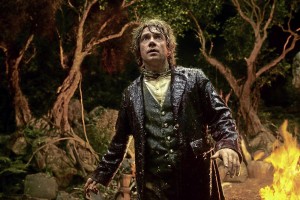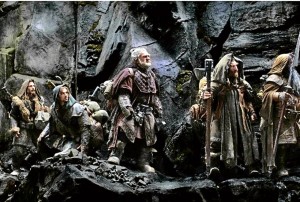
From Oscar-winning filmmaker Peter Jackson comes “The Hobbit: An Unexpected Journey,” the first of a trilogy of films adapting the enduringly popular masterpiece, “The Hobbit,” by J.R.R. Tolkien.
The three films tell a continuous story set in Middle-earth 60 years before “The Lord of the Rings,” which Jackson and his filmmaking team brought to the big screen in the blockbuster trilogy that culminated with the Oscar-winning “The Lord of the Rings: The Return of the King.”
The children’s book “The Hobbit, or There and Back Again” was published by Tolkien on Sept. 21, 1937. Since its first publication, the book has sold over 100 million copies and been translated into some 50 languages. In 75 years, it has never been out of print.
“The Hobbit,” as it became popularly known, emerged from the imagination of the revered author, poet, university professor and philologist as a bedtime story for his children, but the text is illuminated by the author’s love of nature and fairy tales, his experiences in war, and his sense of kinship with humble souls who prevail against insurmountable odds.
The tale of the Hobbit Bilbo Baggins, who is plucked from his comfortable Hobbit Hole and plunged into a wondrous and dangerous adventure in the company of the Wizard Gandalf the Grey and 13 dwarves, has been devoured by generations of readers as a literary rite of passage. It at once defined the call to adventure, the nature of honor and loyalty, the yearning for home, and the quiet courage of the unlikeliest of heroes.
It also introduced to the world the complex civilizations and magical landscapes of Middle-earth—a deep and richly layered world that Tolkien would spend his life exploring in his writings—which would have a profound cultural impact around the world.

Tolkien had moved on from “The Hobbit” to write his three-volume opus “The Lord of the Rings,” but Jackson’s journey went in the opposite direction. Following his experience making “The Lord of the Rings” films, he is now going back in time to tell what was, in fact, the first part of that story, which unfolds 60 years earlier, in a new trilogy, beginning with “The Hobbit: An Unexpected Journey.”
Back to Middle-earth
“When we made ‘The Lord of the Rings,’ I was absolutely sure it was going to be a once-in-a-lifetime experience,” Jackson comments. “It was an amazing and very special time, but when it was over, none of us believed that we’d ever be venturing into Middle-earth again. However, the experience of making ‘The Hobbit’ trilogy became equally special to all of us. So now I have had a once-in-a-lifetime experience twice in a lifetime.”
“The Hobbit has a breathless pace because Tolkien was writing it as a story for his children and for the children of the world,” Jackson notes. “It’s a ripping yarn that moves from event to event, and really doesn’t stop. It’s a little more humorous than “The Lord of the Rings,” the characters are a little more colorful, but it nonetheless has elements of greed and madness, of an innocent who is changed forever, and of the gathering forces that will lead directly into the events in “The Lord of the Rings.” This is where it all starts.”
With “The Hobbit: An Unexpected Journey,” the filmmakers hoped to bring the story to vibrant, visceral life, with all the magic and majesty, humor and darkness, and intimate human emotion that the author himself provided. Screenwriter-producer Fran Walsh notes: “We always saw ‘The Hobbit’ as a slightly more golden-hued fairytale. But, by the time you get to the end of the novel, I think you can see how Tolkien puts himself in the place where he would begin that epic journey of writing ‘The Lord of the Rings.’ That, to us, is our natural transition point into that darker time. The nature of honor and leadership and power—those big themes that are quite prevalent in ‘The Lord of the Rings’—were being awakened in ‘The Hobbit.’”
Mythology
To service this transition in crafting the screenplay, Jackson, Walsh and Philippa Boyens did not simply adapt ‘The Hobbit’ as originally published. What many people may not know is that the author himself continued to develop the story further, ultimately publishing extensive notes about the time in which ‘The Hobbit’ unfolds within 125 pages of appendices that he included at the end of ‘The Lord of the Rings.’
“‘The Hobbit’ was the first time Tolkien let the rest of the world into his incredible mythology, the world of Middle-earth,” says Boyens, the avowed “Tolkien geek” among the screenwriting team. “There are conflicts, relationships and events that are hinted at but not explicitly described in the book. So when Tolkien sat down to write its sequel and ended up writing ‘The Lord of the Rings,’ he took time to revisit the events surrounding ‘The Hobbit’ because he had a very strong sense that within this little children’s book were the seeds of a greater legend.”
This incredible resource freed the filmmakers to grow the world and tell more of the story in their film. But, at the same time, they saw themselves as shepherds of a work they all loved, and as they wove in some of the darker elements, they took care not to compromise the tone of the book.
A production of New Line Cinema and Metro-Goldwyn-Mayer Pictures (MGM), “The Hobbit: An Unexpected Journey” was released in the Philippines by Warner Bros. Pictures on Thursday, Dec. 13.
The second film, “The Hobbit: The Desolation of Smaug,” will be released Dec. 13, 2013, to be followed by “The Hobbit: There and Back Again” on July 18, 2014.

